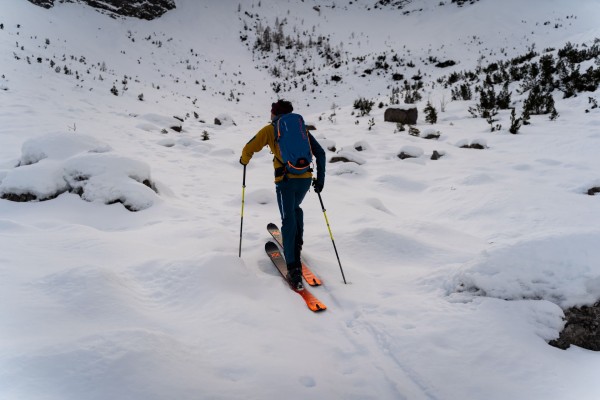Does the touring ski fit to me?
Ski touring is the ideal mixture of mountain hiking, skiing and endurance sports and enables nature experiences away from the hustle and bustle of the slopes, which are normally not granted to the normal " slope skier".
The motivation that drives ski tourers to hike up the mountain can be quite different: One is looking for the sporting challenge of tackling difficult and long climbs, the next is looking for the most untouched descents possible in deep snow, and the third simply wants to put as much distance as possible between himself and stressful everyday life.
These different types have one thing in common: they are ready to break new ground and leave their cosy comfort zone. This is really that time when you leave the comfort zone: because ski touring is a sport that makes quite high demands on endurance and athleticism, and descents in unprepared terrain require quite a bit of technique and skiing experience.
And there are even more challenges: Because simply getting into the binding and setting off is rather less possible when touring. The use of bindings, climbing skins and safety equipment should be practised - and an intensive study of the terrain and the snow and weather conditions is also part of it.
Beginners in this sport should therefore receive appropriate training and entrust themselves to an experienced guide for their first off-piste trips - and never go off-piste alone.
But those who take on all this effort are richly rewarded when ski touring: through close contact with untouched nature, through the feeling of going one's own way away from the crowds and, at the end of a long ascent, through the hard-earned pleasure of a descent through untouched powder - keyword "Earn Your Turn".
What are the characteristics of a touring ski?
Touring skis are as varied as the motivation of skiers who turn to ski touring. What they all have in common is that, in order not to make the ascent unnecessarily difficult, they are lighter than most piste skis and, in order to ensure a certain lift in deep snow, they are wider than most piste skis.
Touring models that are especially optimised for easy and speedy ascents are particularly light, have little pretension and are hardly waisted - these ascent-oriented touring skis are, however, only conditionally suitable for an aggressive skiing style.
Models that are more optimised for wild descents in deep snow are usually significantly wider and therefore heavier than the ascent-oriented models. These downhill-oriented models are therefore not suitable for long hiking tours where the aim is to cover as much distance as possible, but rather to reach particularly attractive powder slopes. Basically, most freeride skis can be classified as downhill-oriented touring skis, provided they are equipped with a touring binding. There are also models that try to combine the skiing characteristics of all-mountain skis with suitability for ascents and are therefore much more suitable than the other variants for skiing on groomed slopes.
Apropos bindings: Touring skis are not usually sold as a set with a specific binding, which means that there are theoretically countless possible combinations. However, not every ski and every touring binding go well together - and not every ski boot is technically compatible with every touring binding either.
The selection of a touring ski is therefore not limited to the choice of ski alone, but includes the selection of an entire set-up of ski, binding, ski boot and ascent aids, which should fit together as well as possible and be optimised for the intended use.
What length should you ski for touring?
If you are looking for an ascent-oriented touring ski or a touring ski with all-mountain characteristics, then you should choose a length that is somewhere between your height and ten centimetres below. If you want a freeride ski with a touring binding, the length should at least match your height. If you want, it can be quite a bit longer.
Touring skis for women
Even though there is nothing to stop women from skiing on men's (or unisex) touring skis, there are good reasons why female skiers should look for models designed specifically for women.
Women's skis differ from men's skis not only in weight and design, but also in their handling characteristics. Women's centre of gravity is usually further towards the hips than men's, and since skiing is all about shifting the body's centre of gravity at the right moment, conventional skis do not always make it easy for women to initiate turns. That's why women's skis are usually constructed in such a way that the body's centre of gravity is further forward to make it easier to turn in.
Are you fascinated by long powder runs? Then our freeride skis could be just the thing for you!
You're often on the slopes, but you also want to take a detour into the backcountry from time to time and are looking for a ski with which you can do both? Then you should take a look at our allmountain skis!
Or is the slope enough for you and you like nothing better than making turns on the freshly prepared snow? Then our race carvers, slalom carvers, sport carvers or all-round carvers could be something for you.




